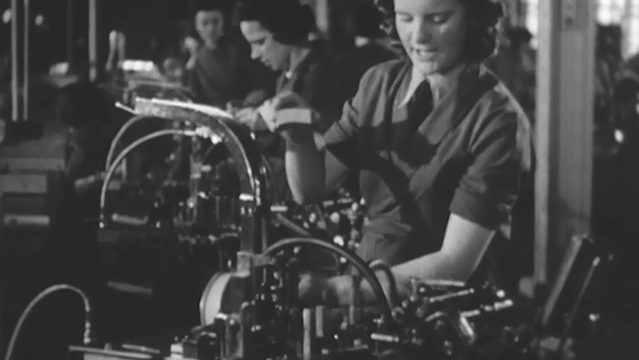Listen to Britain (1942) dir. Humphrey Jennings and Stewart McAllister
Unsurprisingly, European and American filmmaking in 1942 was, like its filmmakers and audience, largely preoccupied with World War II. This was the first year of the Academy Award for Best Documentary, and the category included 25 short and feature nominees, almost all of which were produced by the propaganda arm of allied governments, including all four winners.
Most productions were forwardly educational in one way or another. There were rallying calls for the war effort like in Frank Capra’s “Prelude to War” and instructional videos on the practicalities of conserving resources (like a short with Disney’s Pluto that taught how to save and donate kitchen grease). There were films and newsreels including immediate footage from the frontlines, including John Ford’s famous “The Battle of the Midway” where the director found himself filming in the middle of one of the most consequential skirmishes of the Pacific front.
One of the non-winning nominees, “Listen to Britain,” stands out from the other propaganda pieces, less Capra-esque than Malick-ian in its support of the home team. It starts with the usual bugle calling and roar of wartime engines, then cuts to life on the ground. Spotters stare at the passing airplanes through binoculars while nearby women dig up potatoes and a farmer harvests grain. All are going about their business under the drone of airplane engines, which they glance up to check the markings and whether it’s time to run.
The journey of Humphrey Jennings as filmmaker for the state was a roundabout one that started as a more literary career with studies emphasizing poetry. This history informs Jennings’s assembly of the film in a way that speaks without narrator or the endless snares and brass of other wartime films. Instead of anthems, we hear “Roll Out the Barrell” as dancers revolve around on the floor and “Home on the Range” strummed by GIs relaxing their train. Later, pianist Myra Hess will play a concert as she did many lunchtimes during the tense days of Britain’s bombing. No mention is made in the film that most of the exhibits in the museum where she plays have been evacuated for protection, but you can read in the faces the tension of living day to day in a city in tatters. Men and women work, children play, two performers sway in time and sing on a performance for a crowd of working class faces. You can’t miss the marks of war in scorched city blocks, but you can believe one could hold a thought outside the trenches.
Jennings finally acquiesces to convention and finishes out with “Rule, Brittania!” Others wanted to underline message sooner – when Yankees check out the stunning restoration on Kanopy (and I recommend it for the ballroom shots alone), you’ll see the introduction Americans added where a stuffed-shirt Canadian frames the film to come as “a trumpet call of freedom, the war song of a great people. The first sure notes of the march of victory…” Despite the pushing, it’s hard to experience “Listen to Britain” as pure jingoism. And contrary to the fears of American propagandists, people responded to the simplicity of Jennings’ poetry that acknowledged life in the periphery of the all-consuming battle. It spoke at the time to a people debating among themselves and each other how to cope with war on the homefront. As a document to the past, it’s invaluable to see people as they were, not as the war effort needed them to look.

